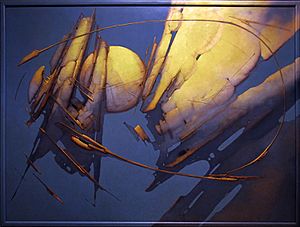Joan Castejón facts for kids
Quick facts for kids
Joan Castejón
|
|
|---|---|
| Born |
Joan Ramón García Castejón
December 17, 1945 |
| Nationality | Spanish |
| Education | Real Academia de Bellas Artes de San Carlos, Valencia, Spain |
| Known for | Painting, Drawing, Sculpture, Engraving |
| Movement | Social realism, Expressionism, Surrealism |
| Spouse(s) | Paca Galván |
Joan Ramón García Castejón, born in Elche, Spain, on December 17, 1945, is an important Spanish artist. He is known as Joan Castejón and is famous for his drawings, paintings, and sculptures. Many people see him as a key artist in the "social realism" art movement in Spain after the war. He was also part of a group of artists called the Grup d'Elx.
His artwork has been shown in many major museums across Spain. These include the Institut Valencià d'Art Modern (IVAM), the Museum of the University of Alicante, and the Museum of Contemporary Art of Elche.
Contents
The Life of Joan Castejón
Early Artistic Journey
When Joan was sixteen, he moved to Valencia. There, he studied fine arts at the Academy of San Carlos. His very first art show was in 1966 at the Mateu art gallery in Valencia. In his early works, from 1964 to 1967, he often drew human figures in simple spaces. These early drawings showed his unique style, with strong lines and detailed human shapes.
Facing Challenges
Joan's art career faced a sudden stop in May 1967. He was involved in protests in Valencia against the government at the time. When he tried to help a friend, he was arrested. He was treated harshly and later sentenced to six years in prison.
Time in Prison

He spent time in prisons in Valencia and Teruel until mid-1969. Even in prison, he kept creating art. During this period, he made about two thousand drawings using wax or pencil. These experiences deeply influenced his art. In 1969, he joined the Grup d'Elx again and showed his work with them until 1971. Because of his activities, he was sent back to prison in the Canary Islands for another seven months in 1971.
Life in Dénia
In 1973, Joan Castejón married Paca Galván. He returned to Valencia for a short time. A year later, in 1974, he moved permanently to Dénia, a small city by the coast. He started painting again, using a strong and expressive style in the late 1970s. In the 1980s, he explored brighter, more abstract art inspired by landscapes. By the 1990s, his drawings became very detailed and dramatic. The human experience became the main focus of his art. He often showed people struggling with life's challenges.
In 1999, the city of Dénia honored him as an "Adopted Son." This was a special recognition for living there since 1974.
Exploring His Artworks
One of the most amazing things about Joan Castejón's art is his incredible skill at drawing. This talent is clear in his paintings too. Writer José Manuel Caballero Bonald once said that Castejón "draws like a classic artist and thinks like a prophet." Enrique Cerdan Tato, a historian, wrote that Castejón wanted to show "a human world revealed by violence." He used powerful shapes, lines, and figures to do this.
After leaving prison, Castejón created a series of one hundred artworks. These were inspired by the famous novel One Hundred Years of Solitude by Gabriel García Márquez. These works were shown in Valencia and Barcelona. The famous writer Mario Vargas Llosa commented on this collection. He said it showed how painting can still be inspired by literature, just like it can be inspired by a dream or a person.
Martí Dominguez, writing in the newspaper El País, praised Castejón's drawing skills. He suggested that Joan Castejón might be one of the best Spanish artists at drawing the human body.
Art critic Román de la Calle noted that Castejón's art shows a deep moral message. He uses symbolic and dream-like elements to share his personal experiences. His skill in showing the human body in an expressive way is very clear.
Between 2009 and 2010, his exhibition "Per a Paca" traveled across the province of Alicante. This show was a tribute to his wife. According to the newspaper La Verdad, it was "a look back at the couple's memories." It featured over 50 abstract artworks, showing moments of pain and surprise from their shared history.
Selected Artworks
Here are some of Joan Castejón's well-known works:
- Maternidad gris (1969)
- The’y were more than three thousand (1973)
- Characters reduced by their own deeds (1974)
- La digestió (1978)
- Mutant d'águila irreal (1980)
- The day (1984)
- A Salvador Espriu (1989)
- Paisatge daurat 1993 (1993)
- El Salt (2002)
- Cavall nocturn (2004)
- The War (2009)
Where to See His Art
The largest public collection of Joan Castejón's art is at the Museum of Contemporary Art in his hometown, Elche. A large private collection used to be at the Lecasse Foundation in Alcoy. This collection had about two hundred works bought by businessman Lionel Grau Mullor. Now, this collection has been divided among his family. The IVAM museum has his collection of drawings inspired by Don Quixote. Many other pieces are part of the Bancaja Foundation collection in Valencia.
Awards and Honors
Joan Castejón has received many awards for his artistic contributions:
- Total Art Work Award, from the Wagner Society of Alicante, 2014
- Premio Ocell, from the Mancomunitat de la Marina Alta, 2005
- Honorary member of the Institut d'Estudis Comarcals del Baix Vinalopó, 2001
- Honorary member of the Institut d'Estudis Comarcals de la Marina Alta, 1999
- Adoptive Son of the city of Dénia, Ajuntament de Dénia, 1999
- Premi la Tardor, from the Universitat Politècnica de València, 1994
- Homage to Joan Castejón. Key of the City of Mont De Marsan, France, 1993
See Also
- Social realism
- Grup d'Elx



